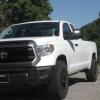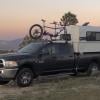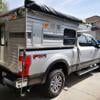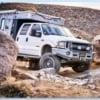Thanks for the info! What is your solar setup and how many days (charge cycles) approximately?
Low cost DIY Lithium camper batteries.
#41

Posted 23 November 2017 - 05:50 PM
#42

Posted 24 November 2017 - 03:13 PM
130W peel and stick, 2 Unisolar panels. Battery management via Electrodacus, Solar Battery Management System (SBMS 120). I've been supporting the Electrodacus Kickstarter for a few years and am now on the third version SBMS. The SBMS has cell balancing and is configurable for various battery types.
The panels feed into input one on the SBMS. The truck feeds input two, via the trailer aux battery supply on the 7-pin connector. The truck voltage needs to be stepped up to a solar panel voltage of around 17V. I do this with a Pololu step-up supply board which can supply up to 5A.
Total cycles is unknown since lose this data whenever I power cycle the SBMS. We rarely get the batteries under 13V so I'm not really cycling them. We have well over 100 nights camping on these batteries, maybe 150. I've been more worried about charging when the batteries are below freezing than low current charging.
#43

Posted 27 November 2017 - 04:33 PM
I ran across some discussion of low charge rates not being good for LiFEPO4.
https://www.eevblog....anging-current/
"Lithium based rechargeable batteries can be damaged (over time) by slow charging currents. This has to do with dendrite growth on the edges of the plates. You do NOT want to trickle-charge these batteries. The only exception I know of is Lithium Titanium Oxide [LTO] chemistry, which is very tolerant to slow charging (but not trickle charging). LTO batteries are still very new and they do not have the nice flat discharge curve that LiFeP04 batteries have. LTO batteries are currently used in very high reliability applications (like medical implants).
If you have a source of power that is unpredictable (such as solar panels, or some other energy harvesting device), it is best to store up energy in a capacitor, and then dump this charge into the battery at a C/2 rate, then let the cycle repeat. The repetition cycle can be as rapid as your source will allow. This type of charge profile will minimize dendrite growth and maximize the lifetime of your batteries."
I was thinking of a 150ah battery so I'd have plenty of room for expansion later. Initially I'd just have a 160W panel. At 10a charge I'd have a .07C charge rate and it wouldn't get much higher than that. A lot of the time it will be lower, with the sun at an angle and cloudy days.
Thoughts?
I have not heard of this issue with lithium batteries before, and it doesn't look like the author of that forum post was able to support it with any sort of reference so I doubt there is much truth to it. The low temperature charging issue is well documented, and the easiest solution is to reduce the charge currents below freezing, so that is what I went with.
2016 Fleet Flatbed
2016 Toyota Tacoma
#44

Posted 27 November 2017 - 04:40 PM
Quick real world update - after a 10 day trip under somewhat difficult power conditions (warm days for the fridge, cool nights for the furnace with low solar angles) the lithium pack is still working as expected. Lowest discharge (parked for 2 days in shady but warm conditions at Aravaipa Canyon trail head) was down to 60% SOC, and generally cycled down to 75% and then back up to 95% SOC with a combination of solar and driving. We did drive some pretty rough roads in Ironwood Forrest National Monument, with no apparent mechanical issues to the assembled pack.
Without any balancing, all the cells are still within 10mV of each other, so balancing doesn't seem like it will be an issue.
2016 Fleet Flatbed
2016 Toyota Tacoma
#45

Posted 27 November 2017 - 05:47 PM
The panels feed into input one on the SBMS. The truck feeds input two, via the trailer aux battery supply on the 7-pin connector. The truck voltage needs to be stepped up to a solar panel voltage of around 17V. I do this with a Pololu step-up supply board which can supply up to 5A.
Thank you both for the info!
I could not find any other comments regarding low charge rates being particularly bad for these batteries, so I've decided not to worry about it. I'm leaning towards hooking it up to the alternator. The alternator might not fully charge it, but it should add quite a bit if the battery is low. I see you are using a voltage step-up for the alternator, which may be a better way to go. But 5a is not a lot.
Does Electrodacus have a temperature cut off? Seems like that would be the best way to prevent low temperature charging.
BTW, this is the most thorough treatment I've found of LiFePO4 on the internet: http://www.pbase.com...on_boats&page=1
#46

Posted 30 November 2017 - 03:21 PM
Rando wrote:
"As for alternator charging, it all depends on your alternator voltage. In my case, my alternator is ECU controlled and quickly drops down to ~13.5V, when combined with my skinnier wires to the battery doesn't provide much charging current. If your alternator stays up at 13.9 - 14.2V you should charge just fine until the BMS shuts off the batteries. If you have heavy gauge wires running back there, you may want to check that you don't pull too much current. These batteries will happily charge at 1C, so 150A draw! You would also need to size your BMS appropriately.
Another, more expensive but more elegant option is a DC-DC charger, which would both boost the voltage and limit the current. You would want one that is adjustable for LiFePO4 voltages."
I'd forgotten this comment. Since my Tundra is the same year as your Tacoma, the alternator probably behaves the same. LiFePO4 cells nominally charge at ~3.45v (13.8v for the pack), so the charge voltage needs to be at least that high. Think I'll backtrack to using only solar for the house battery and keep my starting system the way it is.
Edited by rruff, 30 November 2017 - 03:22 PM.
#47

Posted 03 December 2017 - 03:52 PM
I still get about 4-8A of charging out of my alternator, even at 13.5V, so I wouldn't totally write off alternator charging. It is way less current than you could get out of the alternator, but is about the same as winter time solar charging.
Another inexpensive option I think I mentioned earlier would be to add a DC-DC converter and wire the output to the input of solar charge controller (assuming an MPPT charge controller). Something like this would get you at least 20A of alternator charging if your MPPT is rated for it:
https://www.amazon.c...boost converter
With 2 blocking diodes (one on the DC-DC converter and one on the feed from your solar panel) you wouldn't even need a switch or anything - it would just work whenever the alternator is running.
2016 Fleet Flatbed
2016 Toyota Tacoma
#48

Posted 03 December 2017 - 05:11 PM
Thanks! I hadn't seen anything like that. I was looking at much more expensive 12v-12v chargers.
I'm guessing I'd need an MPPT controller then? Also, have you found a good way to cut off charging at low temperatures?
#49

Posted 13 December 2017 - 09:03 PM
Rando, I'm getting ready to assemble my battery and wondered what are your thoughts on solder vs spot welding? Seems to have much arguments against using a hot iron on the batteries. Buying a spot welder would negate the cost effectiveness of this build. By the way, I did order those plastic holders and it looks like this is the way to go in the assembly of these packs. Thank you for this post!
Ford 2018 F250 FX4,Lariat, Gasser. FWC 2013 Hawk W6QN (formerly KH6FBU)
#50

Posted 13 December 2017 - 11:27 PM
I used a soldering gun to assemble my pack, and it didn't appear to cause any issues. The batteries really don't even get warm to the touch, particularly if you use flux and a high wattage iron that can dump heat quickly into a localized area on the terminals of the cells.
I used a three step procedure - I lined up all the individual cells in their grids, applied flux to all the +ve terminals, then went over with my soldering gun and added a ~5mm diameter pool of leaded solder to each terminal, then finally I soldered the bus wire to the terminals. I pretinned the wire where it was going to be soldered to the terminals. Then I flipped the packs over and did the -ve side. Using this technique it was probably 4-5 seconds with the iron to apply the pool of solder and only 1-2 seconds to solder the wire to each terminal.
The proof is in the pudding though - my battery pack measured in right at 150Ah, which is within 5% of where it should be, so both the cells are OK, and the solder seems to have made good connections.
I have a feeling this is another 'internet controversy' like the low charge rate issue raised above. Sure, if you are soldering AA sized cells and leaving the iron on each cell for 30s it could be an issue, but a few seconds on a D size cell is not going to cause a significant temperature rise.
2016 Fleet Flatbed
2016 Toyota Tacoma
Also tagged with one or more of these keywords: Lithium, LiFePO4, LFP, DIY, Batteries
0 user(s) are reading this topic
0 members, 0 guests, 0 anonymous users

















